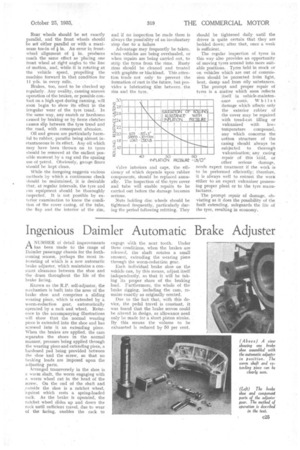Ingenious Daimler Automatic Brake Adjuster
Page 67

If you've noticed an error in this article please click here to report it so we can fix it.
A NUMBER of detail improvements .1-1 has been made to the range of Daimler passengv chassis for the forthcoming season, perhaps the most interesting of which is a new automatic brake adjuster, which maintains a constant clearance between the shoe and the drum throughout the life of the brake facing.
Known as the R.P. self-adjuster, the mechanism is built into the nose of the brake shoe and comprises a sliding wearing piece, which is extended by a worm-reduction gear, automatically operated by a rack and wheel. Reference to the accompanying illustrations will show that the normal wearing piece is extended into the shoe and has screwed into it an extending piece. When the brakes are applied, the cam separates the shoes in the normal manner, pressure being applied through the wearing piece and extending piece, a hardened pad being provided between the shoe and the screw, so that no braking loads are imposed upon the adjusting parts.
Arranged transversely in the shoe is a worm shaft, the worm engaging with a worm wheel cut in the head of the screw. On the end of the shaft and ...outside the shoe is a ratchet wheel, against which .rests a spring-loaded rack, As the brake is operated, the ratchet wheel slides up and down the rack until sufficient travel, due to wear of the facing, enables the rack to
engage With the next tooth. Under these conditions, when the brakes are released, the shaft rotates a small amount, extending the wearing piece through the worm-reduction gear.
Each individual brake shoe on the vehicle can, by this means, adjust itself independently, so that it will be taking its proper share of the braking load. Furthermore, the whole of the brake rigging, including the cam, remains exactly as originally erected.
Due to the fact that, with this device, the pedal travel is constant, it was found that the brake servos could be altered in design, as allowance need only be made for a short piston stroke. By this means the volume to be exhausted is reduced by 50 per cent.
















































































































































